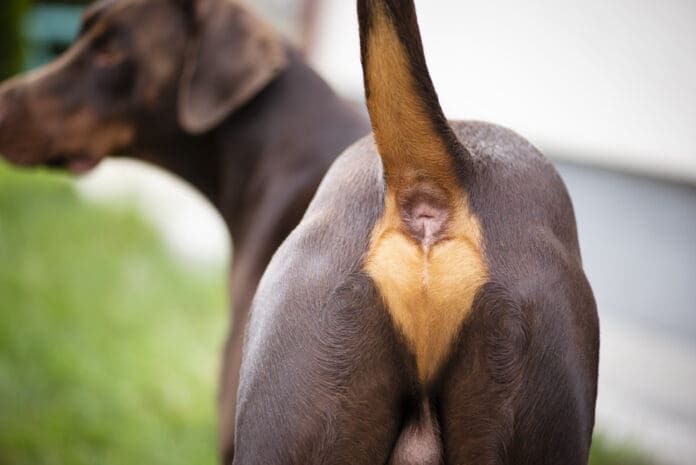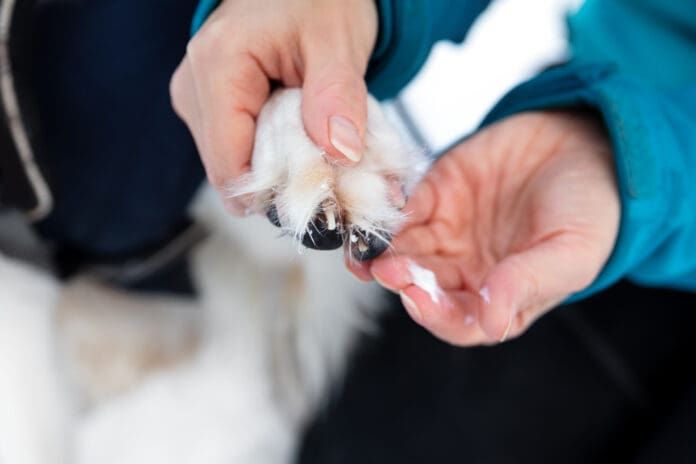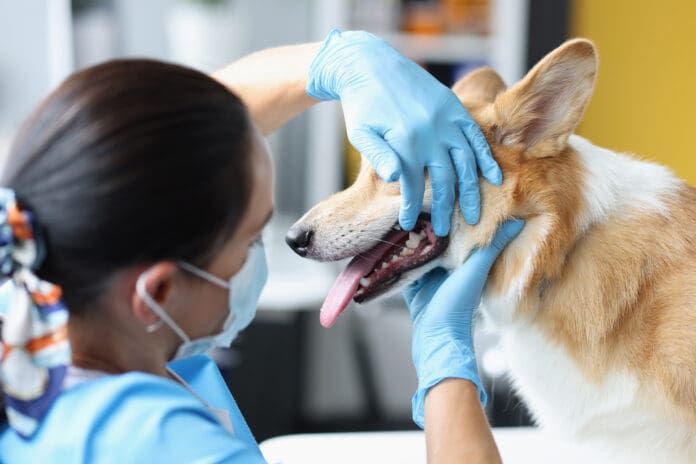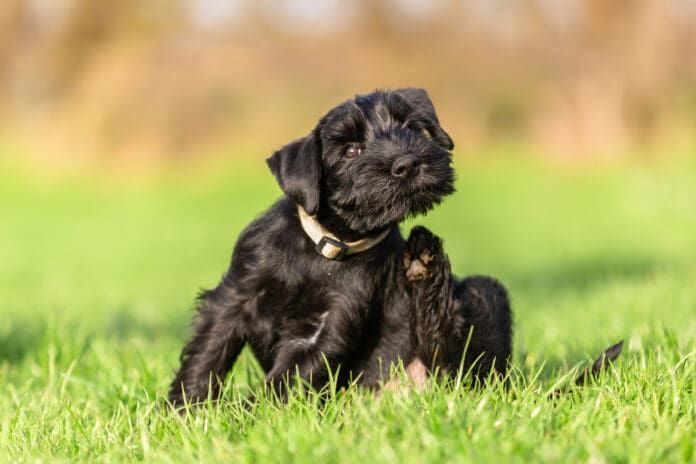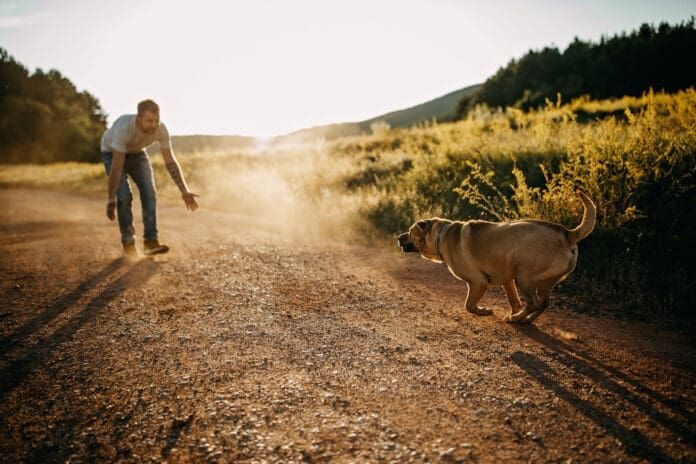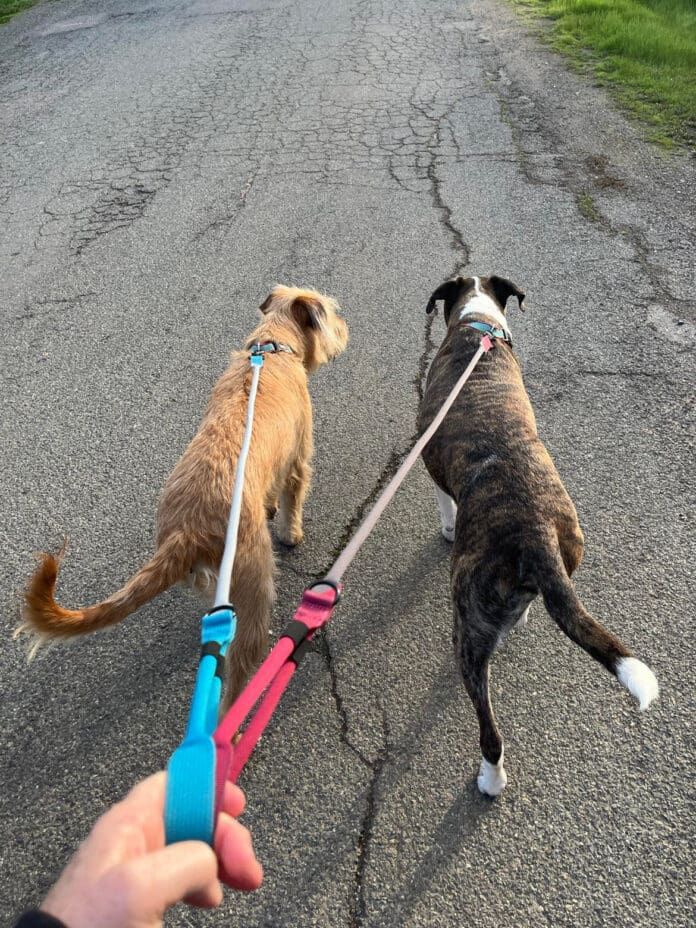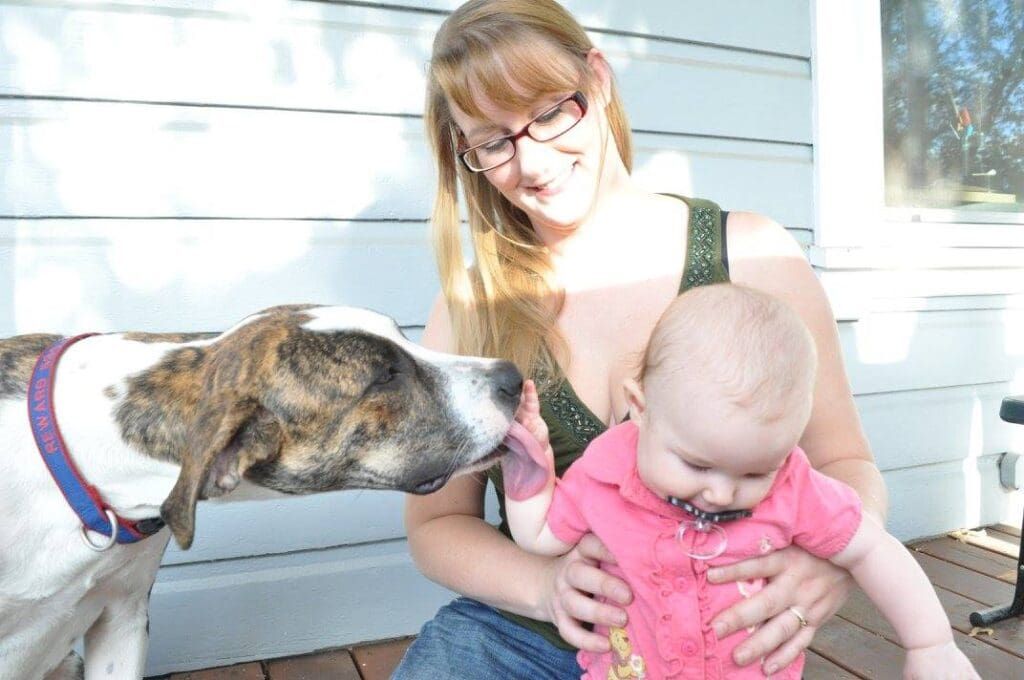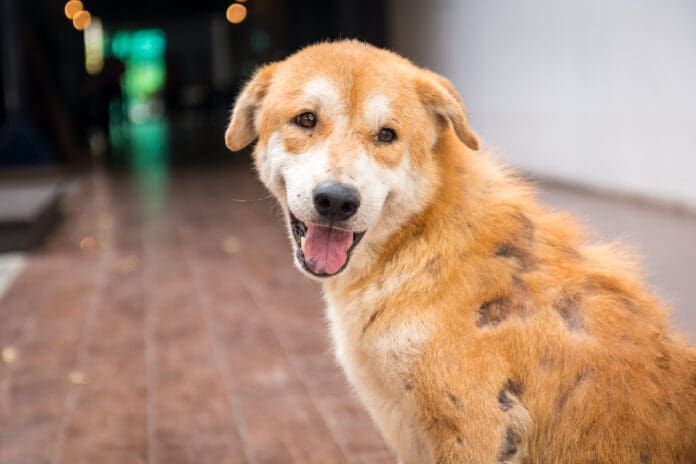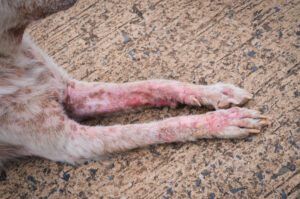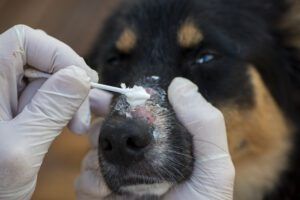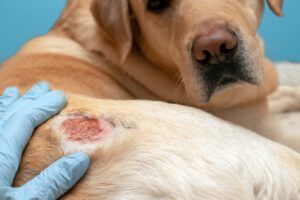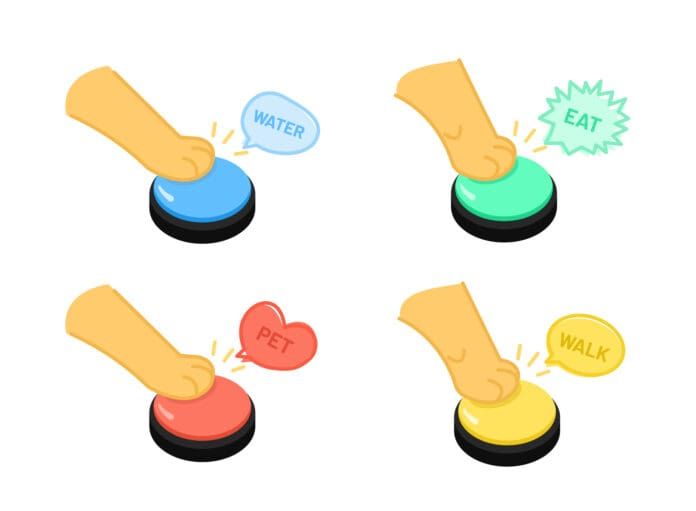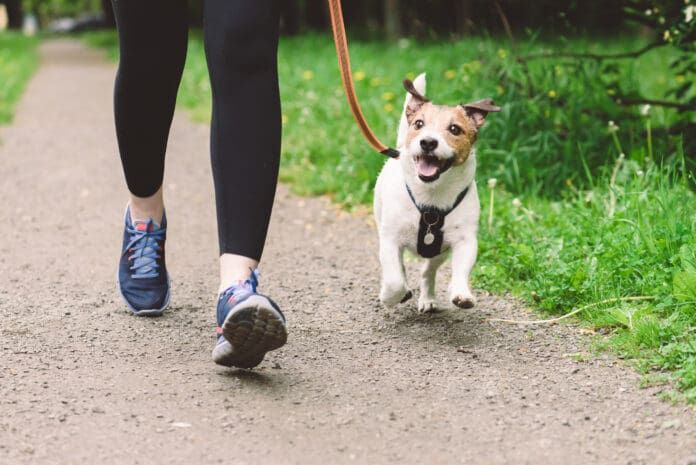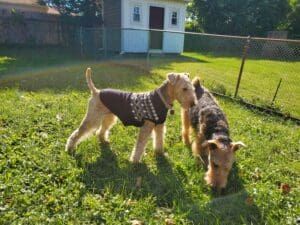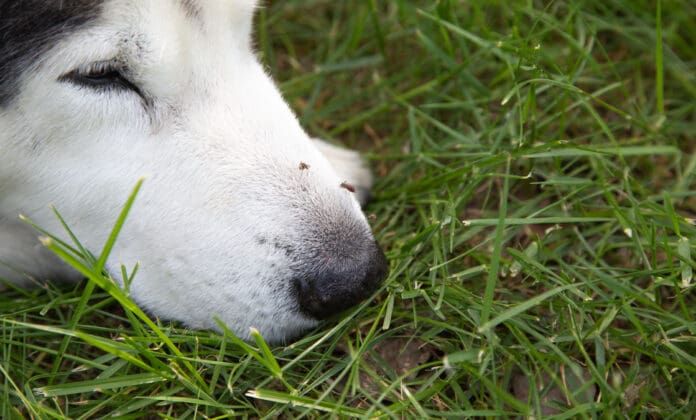Anal glands in dogs are two little sacs that sit on either side of your dog’s anus (where the poop comes out). Picture your dog’s anus as a clock. The tail is at the twelve o’clock position. The anal sacs sit at the positions of four o’clock and eight o’clock.
Each anal sac is lined with sebaceous and apocrine glands—the same type of glands found in a dog’s skin. Unlike their skin cousins, anal sac glands produce a secretion that has a foul, fishy odor. Since they are lined with glands, these anal sacs have become more commonly known as “anal glands.”
Anal sacs are located just below the skin surface. They are sandwiched between two muscles that surround the anus. When a dog has a bowel movement, these muscles compress the sacs against the stool as it passes through the anus. It’s like squeezing the bulb of a turkey baster. This action squeezes the contents of each sac through a duct and onto the surface of the stool.
Anal sac secretions act as a scent marker on the surface of your dog’s poop. That scent marker is like a signature or a fingerprint—his anal sac scent marker is unique to him. It gives other dogs information about your dog’s approximate age, gender, health, and hormonal status (for those that are not spayed or neutered).
How to Know When Anal Glands are Full
Anal glands in dogs will continue producing secretions even if the anal sac is full. A full anal sac can feel like a dog has a marble stuck next to his anus. The pressure and pain caused by a full anal sac will make a dog uncomfortable.
Dogs with full anal sacs will try to relieve this pressure by scooting their butt on the floor or incessantly licking their butt just underneath the tail. They are trying to compress the anal sac to expel its contents and relieve the pressure.
Straining to defecate is another sign that your dog’s anal sacs may be full. The pressure created by full anal sacs can make a dog feel like they have to poop, even when there is no stool in the rectum. These dogs will squat and push in an attempt to relieve the sensation of pressure.
Anal sac secretions can range in consistency from liquid to a thick paste. Dogs with anal sacs that are overflowing with a liquid secretion may experience anal sac leakage when they are sleeping. If this occurs, you might find a small, foul-smelling brown spot where your dog was laying.
Some dogs may involuntarily express their anal sacs when they are frightened or anxious. This does not mean that their anal glands are full. Remember those two muscles that surround each anal sac? One of those muscles is under your dog’s control and the other one is not. The anus muscle that your dog does not have voluntary control over may contract when they are anxious or frightened, causing expression of the anal sac’s contents.
How to Express Dog Anal Glands
There are two methods for expressing a dog’s anal glands—the internal method and the external method. Most groomers use the external method. Veterinarians and veterinary technicians use the internal method.
There are a few supplies you will want to have on hand regardless of the method you use to express the anal glands. You will need exam gloves (latex, nitrile, or equivalent), paper towels, and a deodorizer (see the next section for suggestions).
The external method for expressing anal glands is just as the name suggests—squeezing the anal sacs from the outside of the anus. Don the exam gloves and lift your dog’s tail. Place your thumb and index finger on either side of the 4 o’clock position next to your dog’s anus. Gently squeeze your thumb and index finger together until a brown or yellow liquid emerges from your dog’s anus. Repeat for the 8 o’clock position next to your dog’s anus.
The internal method should not be attempted unless you have been shown how to perform it by your veterinarian or a licensed veterinary technician. Don the exam gloves and lubricate the index finger of your dominant hand with K-Y lubricating jelly. Lift your dog’s tail and gently insert your lubricated index finger about one inch into your dog’s rectum.
Feel for a small grape-sized sac at the 4 o’clock position of your dog’s anus. Place your thumb over the anal sac along the outside of the anus. Gently squeeze your thumb and index finger together until a brown or yellow liquid emerges from your dog’s anus. The anal sac should feel like a deflated balloon when it is empty. Repeat for the 8 o’clock position next to your dog’s anus.
Wipe your dog’s rear end clean with a paper towel. You may apply a deodorizer to rid your dog’s rear end of the foul anal gland smell.
How to Get Rid of Dog Anal Gland Smell
As Lynyrd Skynyrd so poetically sang, “Ooh, that smell!” There are few odors as noxious and distinct as the smell of anal gland secretions. That smell can be difficult to erase once it is on your dog’s fur, your clothes, or your furniture.
There are a few tricks that veterinarians and veterinary technicians use to rid your dog’s fur of that awful smell after expressing your dog’s anal glands. My favorite is an ear cleanser called Epi-otic (made by Virbac). Squirt a little Epi-otic on a gauze square and wipe the fur around your dog’s anus. Epi-otic has a pleasant, fresh scent that effectively neutralizes anal gland odor.
I have also used a product called AOE (Animal Odor Eliminator—made by Thornell). This product is available as a spray and a wipe—both can be used on the fur around your dog’s anus. The spray can also be used on surfaces (including fabrics) and as an air freshener.
Health Issues With Anal Glands in Dogs
There are a handful of problems that can affect anal glands in dogs—impaction, inflammation, infection, abscesses, and tumors. Thankfully, anal gland tumors are rare. But anal gland impactions, inflammation (also known as anal sacculitis), infections, and abscesses are fairly common. My very first case as a newly minted veterinarian was an anal gland abscess!
Anal gland secretions initially have an oily, liquid consistency. These secretions can become thick and pasty if they are not naturally expressed from the sac during bowel movements. Thick, pasty secretions clog the duct draining the anal sac. The glands lining the anal sac continue to produce secretions even if the sac is full. A full anal sac with a clogged duct is called an anal gland impaction.
An untreated anal gland impaction can quickly become an anal gland infection. Bacteria make the journey from your dog’s anus to his anal sacs every day. The bacteria comes from the normal skin flora around the anus and the normal gut flora in the colon. They get flushed out with the anal sac secretions when your dog has a bowel movement. But when an anal sac becomes impacted, the bacteria cannot leave. And then bacteria do what they do best—they grow and multiply. This leads to an anal gland infection.
As the anal gland infection intensifies, your dog’s body responds by sending white blood cells to the anal sac to fight the infection. This creates purulent material (also known as pus). The anal sac is now beyond full with both anal gland secretions and pus. The anal sac and the skin over it stretches so thin that both layers rupture, releasing the contents of the anal sac like a volcano. You may notice a small hole with blood and purulent discharge next to your dog’s anus. This is an anal gland abscess.
Anal sacs can become inflamed if they are expressed too often. This is called anal sacculitis. Anal sacculitis causes an increased production of glandular secretions so that the anal sacs fill faster than usual. In general, dogs should have their anal glands expressed only when needed and no more than once a month.
Dogs naturally empty their anal sacs every time they have a bowel movement. As I mentioned before, the muscles around the anus compress the anal sacs against the stool as it passes through the anus. The anal sacs will not be adequately squeezed if the stool is too soft, if the stool is firm but too small, or if your dog is having diarrhea.
Obese dogs may have difficulty emptying their anal sacs. Excess body fat will accumulate around the anus and between the anal sphincter muscles. Instead of compressing the anal sacs, the anal sphincter muscles will compress the layers of fat in the area around the anal sacs.
Dogs that have a skin condition called seborrheic dermatitis may experience increased production of anal gland secretions. These dogs produce anal gland secretions faster than they can get rid of them, leading to an increased risk of developing anal gland impactions, infections, and abscesses.
There are two types of cancer that can originate in the anal glands—anal sac adenoma and anal sac adenocarcinoma. Anal sac adenoma is a benign tumor of the anal gland that does not metastasize (spread) to other areas of the body. Anal sac adenocarcinoma is a malignant tumor that can metastasize to the lungs, lymph nodes, and abdominal organs. Unfortunately, the majority of anal gland tumors are adenocarcinomas.
Anal gland tumors can be detected during a routine physical examination. If a tumor is found, your veterinarian may recommend bloodwork, thoracic radiographs (chest x-rays), and an abdominal ultrasound prior to surgically removing the tumor and the affected anal sac.
Supplements for Anal Gland Health
Dogs that experience frequent anal sac impactions, infections, and abscesses may benefit from a daily anal gland supplement. Anal gland supplements provide a convenient source of fiber. Fiber creates a stool that is firm and bulky. This promotes proper expression of the anal sacs with each bowel movement.
Some anal gland supplements also contain prebiotics, probiotics and omega-3 fatty acids. Prebiotics and probiotics work with fiber to improve stool consistency. Omega-3 fatty acids may help resolve anal sacculitis. Glandex (made by Vetnique) is one of the more popular anal gland supplements that is recommended by veterinarians.
You can also try adding fiber to your dog’s diet to bulk up his stool. Canned pumpkin, cooked squash, and apple slices are good sources of fiber (and tasty, too!). Talk to your veterinarian about how much of these fiber sources to add to your dog’s daily diet.
Anal Sacculectomy
Dogs that have frequent and persistent issues with their anal glands despite medical and dietary therapy may benefit from having their anal sacs surgically removed. This procedure is called an anal sacculectomy.
Possible complications of anal sacculectomy include fecal incontinence, abscess, or the development of perianal fistula. Fecal incontinence is the most common complication and can occur in up to one-third of dogs undergoing an anal sacculectomy. This complication is usually temporary and resolves in the first few weeks. However, fecal incontinence can be permanent. The rate of complications with anal sacculectomy is greatly reduced if a board-certified surgeon performs the procedure.
Other Anal Problems
There are two other conditions that can look like an anal gland issue but are not. Perianal fistulas may look like a ruptured anal gland abscess. Perineal hernias will create a visible swelling along the side of your dog’s anus and look like an anal gland tumor or impaction.
Perianal fistulas are draining tracts that originate between layers of muscle, skin, and other tissues in the anal region. The anal sacs are sometimes involved but not always. Symptoms of a perianal fistula include one or more openings in the skin around the anus with a bloody or purulent discharge. Dogs may scoot their butt on the ground, lick their butt underneath the tail, or strain to defecate. Perianal fistulas can occur in any breed of dog but are most commonly diagnosed in German Shepherds.
Perineal hernias are when a portion of the rectum, intestines, bladder, or abdominal fat are pushed through the muscles around the anus and hind end (also known as the pelvic floor). Symptoms of a perineal hernia are a large, soft swelling on one or both sides of your dog’s anus. Dogs will strain to defecate and may go several days without having a bowel movement.
Perineal hernias can be caused by trauma (such as being hit by a car) and chronic excessive straining to defecate. Although rare, perineal hernias are most often seen in older, intact male dogs that have an enlarged prostate. The enlarged prostate compresses the rectum and the last part of the colon, causing a dog to excessively strain to defecate every time they poop. The chronic excessive straining weakens the muscles of the pelvic floor, causing a perineal hernia.
Thankfully, most issues with anal glands in dogs can be addressed through changes in diet or the addition of an anal gland supplement. Talk to your veterinarian about the best course of action for your dog’s anal gland issues.



